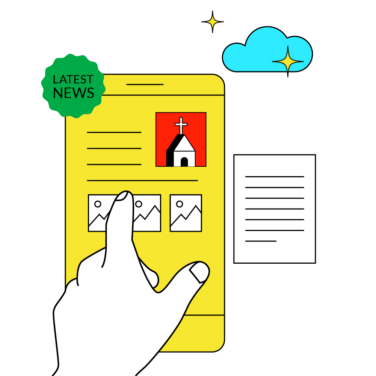If there is one element you should have at the top of your church’s list for every event, church service, or gathering, it should be safety. The security and safety of your congregation and church members is of the utmost importance, especially in this current age.
God calls us to have a mix of faith and physical acts alike (see James 2:26), so while it is amazing and necessary to seek God for protection and guidance, you should also do your part as a church leader to keep everyone safe and secure. You can go about this by creating a church security checklist and overall plan.
This can be daunting and overwhelming, considering the importance of this aspect of your church, but I have your back. I had to create and double (and triple) check security checklists like the one below in my time serving as a church leader in Los Angeles, California.
What Is A Church Security Checklist?
A church security checklist is the list you share with everyone on your church leadership and security teams. These people, including pastors, security guards, ministers, and the like, have responsibilities to check off this list before every single service and event you hold at your church facilities.
This checklist is usually a brief list of tasks that should be done, such as checking certain doors or ensuring the alarm systems work properly. Those responsible for these checklists should double-check, if not triple-check, that every part has been covered off before ever letting someone in through the church doors.
A church security checklist is also a way to organize your safety measures into a digestible format. It lets you keep up with everything you have installed and in place to keep the church members safe, such as your security systems, alarms, cameras, and more. It is an essential requirement for every church today.
11 Point Church Security Checklist
To help you out, I have an example of an 11-point church security checklist below. You can take it exactly as is or mold some of the aspects to fit your church safety needs.
You can even add onto this list, though I would highly suggest against removing any of the parts here.
- Test fire alarm, replace fire extinguishers, and check security cameras frequently
- Check and lock exit doors not in use
- Check and lock windows not in use
- Position security guards at all entrances and exits
- Have constant communication, such as through walkie talkies or radios, between security members
- Put up maps and signage in public areas for emergency exits and plans for all visitors
- Install and check cameras in strategic walkways, entrances, etc.
- Have a dedicated sign-in and check out system for kids ministries
- Connect with local law enforcement
- Come up with a detailed security plan that every leader is aware of
- Seek God for guidance and protection at all times
How To Make A Security Plan For A Church
A checklist isn’t enough for churches these days, as you need a dedicated church security plan as well. This is your executive document and plan that should be shared with the main leaders and it helps you to cover many of the points on the checklist above.
There are elements for emergency situations, emergency response, and how to vet people on your team, all with the purpose of creating the safest environment possible for people to learn about Jesus and the Bible.
1. Make Connections With Local Law Enforcement
You should always reach out and connect with your local law enforcement and first responders, such as the police and fire departments, before ever holding a service. Oftentimes, you can even get a police officer to guard or be nearby during events or service put on by your church event management team.
We were able to do this with LAPD in Los Angeles, so do your best to try this in your community in the event of an emergency.
2. Find Your Church’s Security Weaknesses and Flaws
When it comes to creating a church security plan, you need to first identify where you lack safety. Is there a window that’s broken or obvious obstructions to exit routes? Do you not have a camera in that one dark walkway? Are there exposed valuables?
It isn’t fun but you need to find where you’re lacking and where someone can take advantage of so you can fix that problem before something happens.
3. Create a Dedicated Security Team
Every church needs a dedicated security team as part of their plan. With the vast spectrum of congregation sizes, the size of your team and the roles that you include will vary, but you should always have at least one person stationed at every entrance and exit.
Plus, have guards patrolling the premises and parking lots for any suspicious activity. Bonus points if these security team members have prior experience in security, military, leadership, or law enforcement.
4. Run Background Checks on All Leaders and Volunteers
It doesn’t matter if they are the lead pastor of the church or the brand new volunteer who greets at the door, you need a background check on everyone before they start serving. I had background checks done on me at the churches I led for many years. No one should be bothered by this; it’s just standard procedure.
While you won’t catch every bad apple this way, you can prevent some unnecessary additions to your church team.
5. Properly Train Everyone on Security Measures
After you background check and vet every person on your church team, you also need to properly train them on your security plan and measures. This includes helping them be aware of everything going on, aware of what to do in various scenarios, and actively participating in marking off your church security checklist.
6. Create and Share Emergency Plans
This takes time in itself but it is necessary to create emergency plans for what to do in natural disaster scenarios and manmade issues. I recommend working together with third-party law enforcement or security companies to do this, as they can help point out the best exit strategies.
When you’re ready, share maps and plans for things like fires, earthquakes, or hurricanes in public areas like the foyer, lobby, major hallways, and bathrooms.
7. Devote Resources and Volunteers to Child Safety
I worked in a children's ministry for a long time, and I can tell you it is likely the most nerve-wracking part of church security. I have had to stop some wild people from entering the building in my time serving that I won’t get into here; just know that you need to devote everything to child safety.
It isn’t enough to have kids ministry leaders; you need a dedicated security team, state-of-the-art alarms, tightly-monitored entrances, and a flawless check-in system. And please, don’t let your volunteers and church leaders give a pass to someone to come into the children’s area or pick up a kid just because they know them.
I would argue that children’s ministry is the single largest concentration of frequent security issues, so put forth the money and resources to address these problems.
8. Make a Contingency Plan
Finally, have your contingency plan(s) in place and make them known to all of your staff members on the safety team for if or when the worst happens. Know exactly what you’ll do if the power goes out, if a flood happens, a threat occurs, a child is endangered, a thief breaks in, or a dangerous or suspicious person enters the church building.
These aren’t fun to make and think about, but it has to happen. You need to be ready and prepared for anything. And if nothing ever happens, great! But if God forbid something bad does happen, at least you were as ready as you can be.
12 Best Practices For Church Security
Now that you have the resources in front of you to make your own church security checklist and church security manual, there are some additional best practices and tips I have for you.
These are quick ideas and features to keep in mind for risk management across your church grounds and campuses.
- Safety first in everything you do, be it at your church or an external location.
- Pray for protection and wisdom on how to deal with tough situations.
- Always know what you’re going to do if a specific horrifying scenario happens.
- Don’t ever pretend or say that it can’t happen to your church.
- My motto is “hope for the best, but prepare for the worst.”
- Technology is your friend and help for security. Don’t shy away from cameras, special alarms, or other tech.
- Be prepared to spend a massive budget on security. Everything else can and should wait if you aren’t fully prepared when it comes to safety.
- Actively listen to God and the Holy Spirit for direction.
- Move to live-streaming church services online when necessary.
- Learn from mistakes and flaws, and do everything you can to not let them happen again
- The church members are your spiritual family. Put them first in safety as you would for yourself and your family.
- Keep a manageable scope. It is fine to expand your church with new buildings and facilities, but do so in a smart and safe way where you can still actively monitor everything.
Ensure Your Property and Facility Is Up To Par
Church security is, unfortunately, a second thought for some churches. Don’t let your church be that way. Safety only starts here and it continues with active participation on your part to dedicate the finances, resources, and workers to keep everyone safe.
In addition to the security checklist above, you also need to carefully consider how you manage your church property. You want to keep everything neat and in great condition, so it not only looks nice, but so everything can proceed in an orderly, organized, and safe manner. This goes for your exterior church facility management, too, like food banks and other ministries.
As always, be sure to subscribe to The Lead Pastor newsletter as well to get more tips like this. Managing a church and having the responsibility to care for dozens, hundreds, and thousands of lives is daunting, but you aren’t alone. We are in this together.



